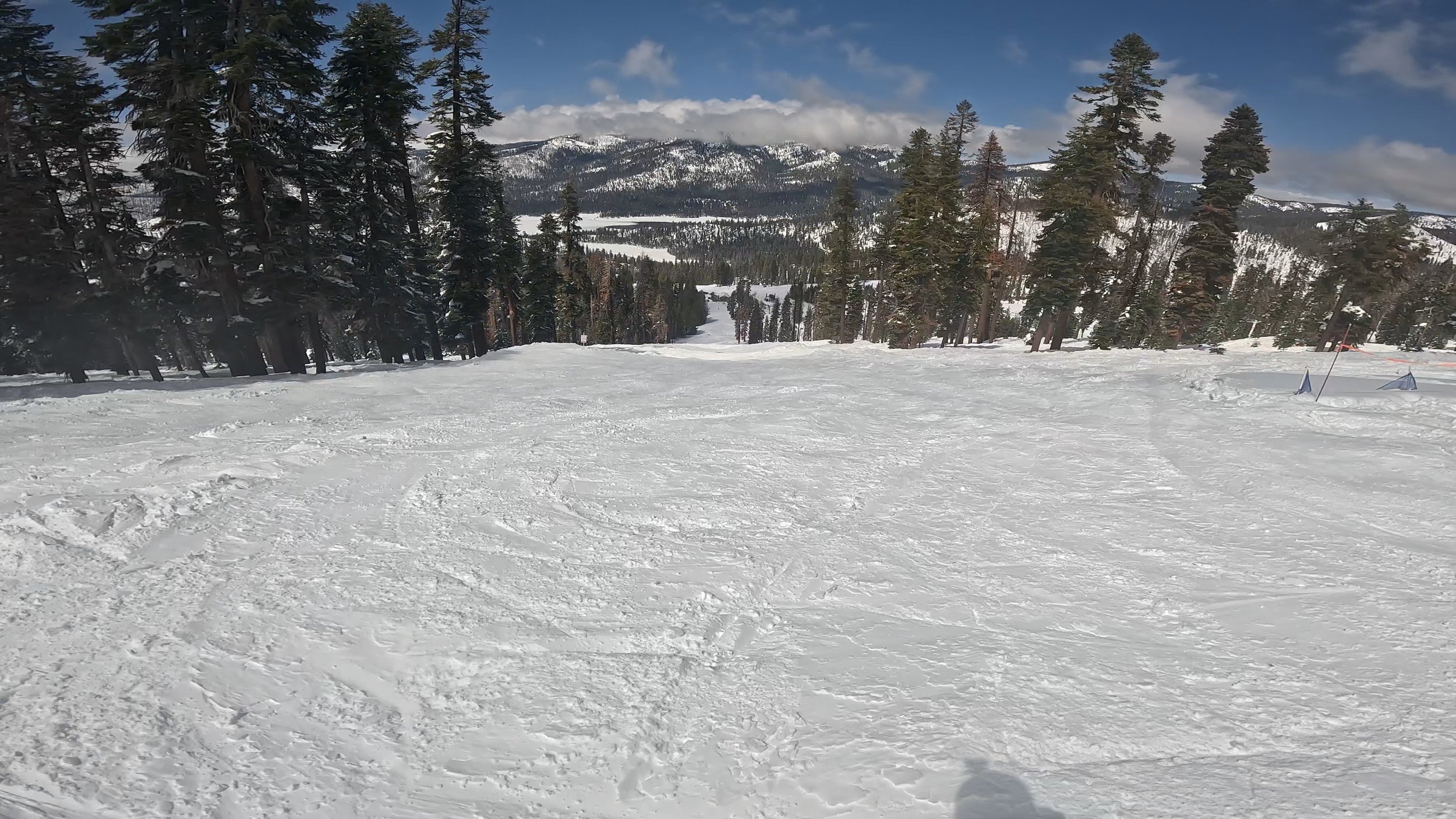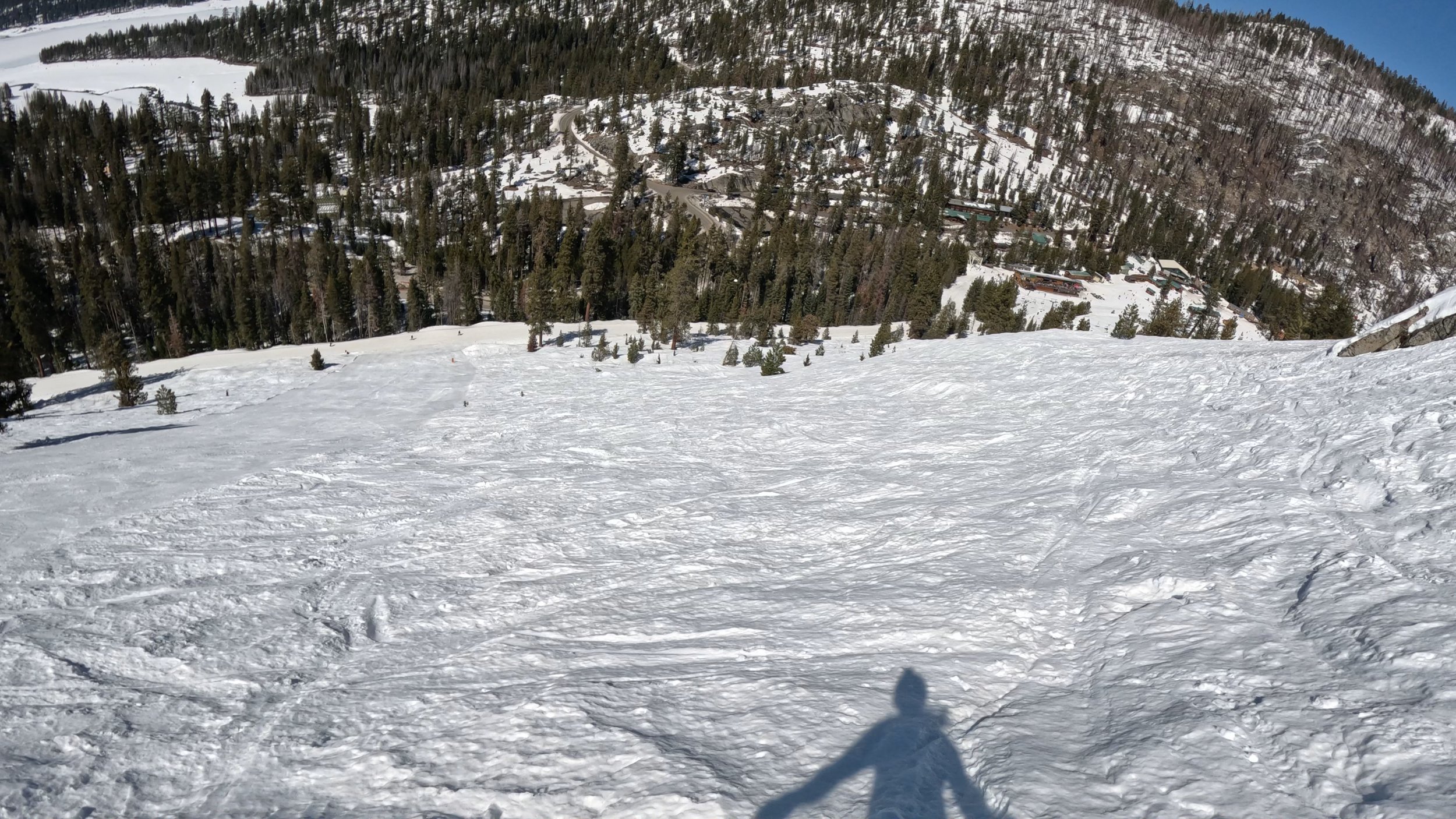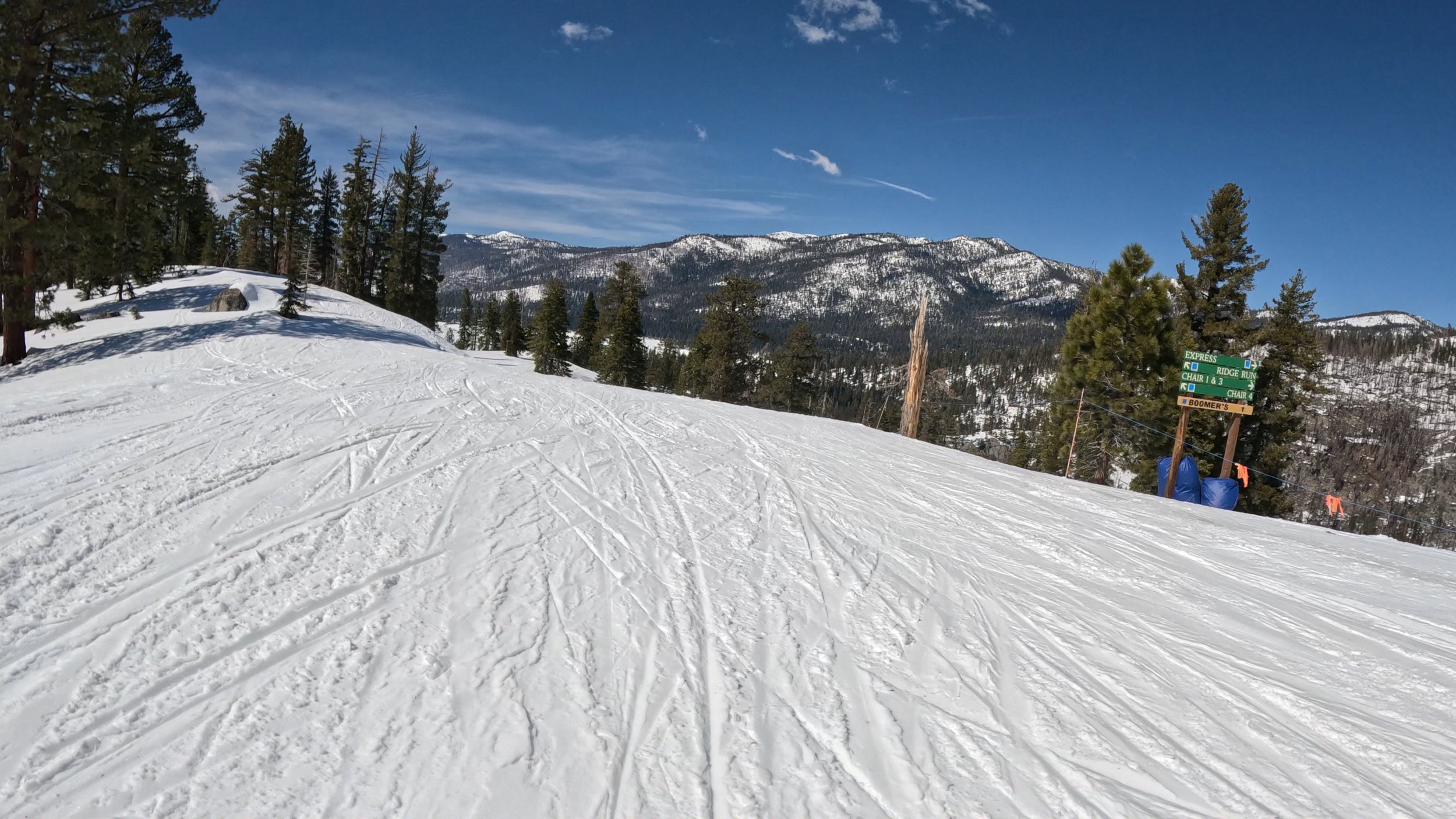Mountain Review: China Peak
MOUNTAIN SCORE
CATEGORY BREAKDOWN
See our criteria6
Snow:
5
Resiliency:
4
Size:
6
Terrain Diversity:
6
Challenge:
3
Lifts:
9
Crowd Flow:
7
Facilities:
7
Navigation:
6
Mountain Aesthetic:
GOOD TO KNOW
1-Day Ticket: $133-$155
Pass Affiliation: Indy Pass, Cali Pass, Powder Alliance
On-site Lodging: Limited
Aprés-ski: Limited
Nearest Cities: Fresno (1.5 hrs), Bakersfield (3 hrs), San Francisco (4.5 hrs)
Recommended Ability Level:
+ Pros
Low crowds
Sunny slopes
Solid intermediate-to-advanced terrain for the size
Easy access from Fresno
– Cons
Slow lifts
Limited beginner terrain
Variable snowfall totals
Lift ticket prices
MOUNTAIN STATS
Lifts: 6
Trails: 54
Beginner: 11%
Intermediate: 63%
Advanced/Expert: 26%
Mountain Review
Unless you live in the Central Valley of California, you probably haven’t heard of China Peak. Rising just under 1,700 vertical feet and only consisting of around 650 acres, this Sierra Nevada resort doesn’t exactly have the build to put up a serious fight against the destinations. But while it’s not as big, snowy, or gnarly as Tahoe or Mammoth, is it still worth a trip?
China Peak can generally be broken into five separate terrain pods, each served by a dedicated lift.
Snow
China Peak is often blasted by the same storms that hit the rest of the Sierra Nevadas, but overall averages a bit less than others in the range, at around 215” per year. The California sun often beats down on the snow, frequently causing freeze-thaw cycles to occur and making snow less desirable to ski or ride a few days after a storm. However, extensive grooming operations help maintain a baseline level of consistency on many runs. Snowfall at China Peak is also extremely variable year to year, though recent investments in snowmaking have helped mitigate this unpredictability to an extent.
Terrain Diversity
Despite its smaller footprint than other California ski areas, China Peak offers a decently broad range of terrain types. Guests will find options ranging from groomers to obstacle-riddled steeps, often in separate pods that allow skiers and riders of different abilities to spread out. This, combined with China Peak’s modest visitation, makes it so that visitors of different ability levels rarely overlap.
China Peak’s base area is exceptionally wide, and it takes prolonged traversing across a bunny hill area to get from one side to the other.
Terrain Layout and Base Area
The ski area can generally be broken into five separate terrain pods, each served by a dedicated lift: Canyon and Park in the lower mountain, and Lakeview, Buckhorn, and Peak in the upper mountain. The resort also features a base-to-summit lift, the Summit chair, which indirectly serves all five terrain pods and extends the entire vertical of the ski area. The Summit chair also serves a few runs, however some of these runs can be lapped via the Canyon chair.
From the base there are two lifts out, one being Summit and the other being Canyon. While the Summit lift provides access to nearly all of China Peak’s terrain, this top-to-bottom lift involves an agonizingly slow 15 minute ride, meaning that besides lapping some of the lookers' right steeps or going to another terrain pod, it isn’t the best lift. The Canyon lift involves a shorter ride time and provides quicker access to the mid-mountain lodge, but this lift is 800 feet away from both the Summit lift and the main parking lot, and the traverse over can wear you out before you even get up on the mountain for the day.
TRAIL MAP
Beginner Terrain
China Peak doesn’t have much in the way of official beginner terrain, but the resort is still reasonably family-friendly. Only one green-rated trail route (officially three different trails, but all in continuance of one another) exists on the main mountain, and some spots get quite narrow and congested, especially between the bottom of the Park lift and the base. While this beginner route used to run from top to bottom, the top section of the Academy trail between the summit and the Canyon unloading area has recently been redesignated as a blue; however, the run itself hasn’t changed, and typical beginners should still be able to handle it.
There are also a few options for easier blue trails off the Park lift, and despite sharing the lift with the terrain parks, the trails are well separated. For true first-timers, the bunny hill area consists of four different carpet lifts of varying lengths and difficulties.
Despite its family-friendly footprint, China Peak lacks much in the way of beginner terrain.
Intermediate Terrain
For intermediates, China Peak offers a few easily lappable pods of blue-rated cruisers and easier glades. The Lakeview and Buckhorn pods offer solidly pitched runs, with runs getting harder from skiers’ left to skiers’ right. The Peak chair, which is right next to Buckhorn, has some steeper runs that upper intermediates can test their mettle on as well. In the lower mountain, the best blue runs are served by the Canyon chair; however, these runs involve a long, flat traverse to get back to the lift at the bottom.
More than 60% of China Peak’s terrain is rated as intermediate, and the resort is ideal for those looking for groomed cruisers and easier glades.
Advanced Terrain
Advanced-level skiers and riders will find plenty of options at China Peak, with the resort offering a mix of bump runs, steep groomers, and wide open, albeit short, bowls. The Peak chair often has a groomed route down, which is great for speed runs. Additionally, the Canyon zone features some particularly steep slopes, notably in the Face area; this area boasts the Juniper run, which China Peak calls the steepest groomed run in California. However, the Face runs end abruptly at the Academy green run, making it crucial for skiers and riders to curb their speed before reaching this junction.
China Peak’s Face area hosts some seriously steep terrain.
Expert Terrain
Experts will find a few challenging options at the resort, though access to some of the toughest runs can be difficult. Hiking from the Peak chair for about five minutes leads to the East Bowl, which has some large cliff drops—some of which are not easily visible—and small rock chutes. The Buckhorn run offers the steepest in-bounds pitch, with rock drops and steep bumps throughout the run, although the return traverse back is very long and flat. The Waterfall Bowl consists of a steep, rocky wide-open bowl with some drops on the edges of the runs. Many of the trees between runs on the lower front side also involve expert-level features, and the tree spacing here allows for some interesting glade runs through blackened tree trunks from past fires. The Face area also has some cliff bands, though the treeless slopes get sunbaked much quicker than other areas.
RECOMMENDED SKIS FOR CHINA PEAK
NOTE: We may receive a small affiliate commission if you click on the below links. All products listed below are unisex.
Recommended intermediate ski
Recommended advanced ski
Recommended high-alpine ski
Recommended powder ski
Terrain Park
If you’re looking for some park laps, China Peak’s setup is decently competitive for what’s essentially a regional hill. Guests will find freestyle features for all skill levels, including boxes, rails, jumps, and even a halfpipe in some years.
Firebowl Area
The Firebowl area used to be served by a T-bar, and consisted of some upper mountain beginner runs, and was supposed to be re-opened with a used Quad in the summer of 2024, but that has been pushed back due to that lift being used elsewhere in the California Mountain Resorts portfolio. It’s a bit of a shame, as this area would be a fantastic move up from the beginner area at the base, and allow for some great views for beginner skiers.
China Peak’s mid-mountain Buckhorn Lodge is located in a very convenient place.
Facilities
If you’re looking for a break from the sun at China Peak, you don’t have to go too far. While there is only one mid-mountain lodge, the Buckhorn Grill, its placement is fantastic. Not only can visitors get to this building from the top of every lift, but it’s high up enough that guests can directly ski or ride to the loading station of any lift on the mountain after stopping in there. This grill offers a few food options and a full service bar, as well as occasional live music.
The base area has two food options, one at the bottom of the Canyon chair and one at the bottom of Summit, and prices are reasonable by ski area standards. Each base area facility also has a full service bar, and they have a low key, local atmosphere.
Besides a few flat traverses, China Peak is fairly easy to get around.
Navigation
Besides the long, catwalky Academy run, flat base area, and long runouts for the skiers’-right-most lower-mountain steeps, getting around China Peak is relatively straightforward. The modest footprint and singular base area make it difficult to get truly lost.
Lift Infrastructure and Crowd Flow
China Peak’s lifts are all slow fixed grip chairs. No high-speed laps to be found here. That being said, they are all triple or quad chairs, making loading easier compared to the ancient center pole doubles found at other midsized mountains. This layout of high capacity fixed grip chairs (yes, fixed grip chairs have the same capacity as high-speed chairs) makes for a mountain that rarely sees lines, and the time you lose on the chair is made up with that fact. In fact, lines more than five minutes are unheard of under normal conditions, even during peak times.
All of China Peak’s chairlifts are slow, but lift lines are essentially nonexistent.
Getting There
China Peak is located less than two hours from the Central Valley city of Fresno. The resort is technically just southwest of Mammoth Mountain, but due to the impassable Southern Sierra Nevadas, the drive between those two resorts is over six hours. Other large California cities, such as Bakersfield and San Jose, are a bit further, at three and four hour drives respectively, with the San Francisco International Airport sitting about four-and-a-half hours away.
China Peak’s access road is notably long, with the twisty, mountainous sections taking over an hour to drive even on good days with no weather issues. Driving up with chains or 4WD/AWD is often required during the winter months.
Parking
Parking at China Peak is pretty close to the base, with paid parking close to the Canyon lift and free parking close to the Summit lift. Recently, the Summit chair has had some mechanical issues, which has made for a longer walk to get on the slopes from the free parking area; that being said, a lift replacement is supposedly in the future.
While it may not compare to the Tahoe resorts further north, China Peak offers a distinctively isolated feel.
Mountain Aesthetic and Isolation
The long drive to get to China Peak does have one advantage, and that’s the isolation you feel being here. The resort base is the only truly built-up area visible across the entire resort, and views from the ski area include the surrounding mountains, many of which are filled with burned trees from recent fires, and Huntington Lake, a picturesque reservoir. From the peak looking west, one can gaze down into the Central Valley 8,000 feet below. However, the common haze in the valley often diminishes the view, making it less spectacular than it might sound.
Lodging
Despite its remote location, guests looking to stay near China Peak overnight will find a few convenient accommodations. The small Inn at China Peak provides ski-in/ski-out lodging at reasonable rates for a slopeside accommodation. Additional lodging options are available in the nearby town of Shaver Lake, which is 30 minutes down the road.
RECOMMENDED SNOWBOARDS FOR CHINA PEAK
NOTE: We may receive a small affiliate commission if you click on the below links. All products listed below are unisex.
Recommended intermediate board
Recommended advanced board
Recommended high-alpine board
Recommended powder board
Après-ski
China Peak is mostly a day trip mountain, but the resort does have a handful of base bars for après. However, these slopeside bars close right at 4pm, and the hotel bar has quite inconsistent hours in the winter. This makes for a minimal après experience, and most visitors drive back down to Fresno after the lifts close.
Despite its modest size and remote location, China Peak’s lift tickets are not cheap for what you get.
Verdict
One could argue that China Peak’s biggest appeal is its proximity to the Fresno area, but if you’re looking for a mountain with surprisingly diverse terrain, well placed facilities, and no lines—and you don’t mind slow lifts and a smaller mountain—China Peak may fit the bill as a regional destination. While it’s no substitute for a true destination ski resort, those looking for a change of pace from the popular California resorts may get a lot out of a day or two here.
Pricing
China Peak recently saw a change in ownership, and tickets prices have risen significantly since then. 1-day adult rates now top out at $155 on peak dates, making a trip to China Peak really tough to justify for the quality of slopes.
A season or multi-resort pass is the way to go to access China Peak these days. China Peak is on the Cali Pass, which accesses China Peak, Dodge Ridge, Bear Valley, and Mountain High, and costs between $500 and $800 depending on time of purchase. China Peak is also on the Indy Pass, which provides two days of access to over 100 ski areas around the world.


























